Implementation, application and analysis of modeling tools (coupled physical-biogeochemical model SHYFEM-BFM) for the study of environmental processes in coastal areas/lagoons
Ocean Sciences, Modeling
Research area
The land-sea interface is extremely heterogeneous in terms of primary productivity, air-sea fluxes, benthic fluxes and sediment transport processes. Climate change and human activity have the potential to influence – with different levels of impact - the carbon cycle along this continuum through changes in river discharge, vegetation, nutrients and organic matter delivery, and transformation processes. Within the last several years there has been an increased focus on biogeochemical cycling at the land-sea interface and concern about how the processes occurring along this land-sea continuum might change in future. Advancement in our current understanding of the interconnected processes that drive biogeochemical cycling and transport along this critical transition zone is needed, with special emphasis on sediment-water interactions on local and regional scale, as well as efforts that improve the representation of these dynamics in spatially complex shallow coastal environments.
Project goals
The Marano and Grado Lagoon is a shallow coastal system of regional and international ecological importance, located in the northeastern coastal area of Italy. The impact of anthropic pressures due to significant socio-economic activities, particularly the excess of nutrients (mainly nitrate), requires knowledge and tools to understand the lagoon's trophic dynamics and to support comprehensive management strategies. The project aims to model the environmental dynamics of the Marano and Grado Lagoon, utilizing both observational data and a coupled physical-biogeochemical model, and characterize the spatial distribution and seasonal trends of physical-chemical and biogeochemical parameters. The development of the coupled model will include explicit benthic-pelagic interactions and will also be supported by a new monitoring network. The inclusion of the benthic dynamics in the biogeochemical modeling of a shallow coastal lagoon, such as the Marano and Grado lagoon, represents an innovative application in the field of coastal biogeochemistry, since benthic biogeochemical feedbacks can significantly constrain the coastal environmental dynamics. The aim of the new monitoring network, that is about to be installed, integrated with the existing monitoring system of the Regional Environmental Protection Agency, is to improve the definition of the exchanges at the lagoon inlets, of the inputs at the rivers-lagoon interface and to better evaluate nutrients levels inside the lagoon.
Computational approach
Currently the simulations are carried out with the 2D version of the SHYFEM-BFM model and are run on the Tier-1 class system, GALILEO100 (G100), installed in 2021 with 8260 IntelCascadeLake nodes. To maximize the performance of the coupled modeling system for the case of the Marano and Grado lagoon, a compromise of the configuration between efficiency and solution time on the G100 architecture is represented by 1 node with 14 processors. With this configuration, a yearly simulation with the 2D SHYFEM model takes approximately 3-3.5 hours, while if the BFM is added the model requires more than 24 hours, so it is run in two 6-month tranches, enabling the restart. The challenge is to run a significant number of tests in less time and to switch to the 3D version of the model.
The recent implementation of an MPI-based parallelization in the SHYFEM model allows it to run about 2-3 times faster compared to the previous OMP-parallel version, using the same computational resources (run time estimated for 14 processors), so the MPI-based parallelization in the SHYFEM model has to be tested on the TeRABIT infrastructure.
Figure – (a) The new grid of the Marano and Grado Lagoon, with the representation of three different types of areas (flats, channels and seagrasses). (b) Average distribution of modeled Nitrates (mmol N/m3) over the year 2013. (c) Average distribution of modeled Dissolved Oxygen (mmol O2/m3) over the year 2013.
Isabella Scroccaro
Istituto Nazionale di Oceanografia e di Geofisica Sperimentale
I am an environmental scientist with many research interests, in particular in the area of marine coastal waters, lagoons and wetlands (modeling and management). I have experience in European projects for integrated coastal zone and watershed management, conducted mostly in Europe. Currently I am working as a researcher at the National Institute of Oceanography and Applied Geophysics – OGS, in Trieste, Italy. My experience in numerical models includes the application of the SHYFEM model and NEMO model, coupled with the biogeochemical model BFM (Biogeochemical Flux Model), to coastal systems and shallow waters. My previous experience at the Regional Environmental Protection Agency of Friuli Venezia Giulia (ARPA FVG) deals with water quality and numerical modeling of the coastal zone, since models may be used as a scientific and technical tool to support the requirements of the European Directives.










